Article and photos by Joe Sapia
Note: The yard references are to my house in the section of Monroe between Helmetta and Jamesburg in South Middlesex County. My yard is in a Pine Barrens outlier on the Inner Coastal Plain, the soil is loamy, and my neighborhood is on the boundary of Gardening Zones 6b (cooler) and 7a (warmer). Afield references are to the Pine Barrens around Helmetta, unless otherwise noted. Notes and photographs are for the period covered, unless otherwise noted.
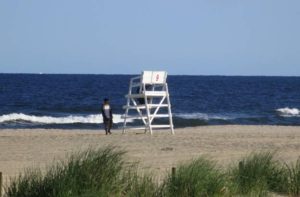
The Atlantic Ocean beach at Bradley Beach, Monmouth County
THE JERSEY SHORE SUMMER SEASON: The traditional Jersey Shore summer season arrives with Memorial Day Weekend, this weekend, and ends with Labor Day, this year September 4. (A tip: Jersey Shore people know September is a great month at the Shore – the crowds are gone and the weather and ocean are still warm.)
SPRINGTIME AT TONY’S MARKET: A favorite Jersey Midlands place of mine for decades has been Tony’s Farm and Garden Center in the Windsor section of Robbinsville, Mercer County. A nice selection of various products and owned and operated by the warm and helpful Ciaccio family. I regularly patronize three nursery-garden centers: Ferris Farms in East Brunswick, Krygier’s Nursery in South Brunswick, and Tony’s. At Tony’s, I buy houseplants and houseplant supplies. And I try to always shoot photographs at Tony’s.

Flowers at Tony’s Farm and Garden Center in the Windsor section of Robbinsville, Mercer County.
SIX-MILE RUN RESERVOIR SITE: On Wednesday, May 24, I hiked this area in Franklin, Somerset County, with the Outdoor Club of South Jersey. The area, about 3,000 acres and part of the Delaware and Raritan Canal State Park, had been planned for a reservoir, but that did not come to be. The terrain of red shale soil and traprock is part of the Piedmont geologic region. While pretty terrain – an area that I want to re-visit soon – much of it appears to be grown-over farmland, rather than a pure ecosystem.
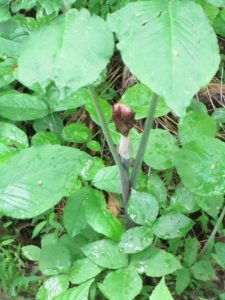
A Jack in the Pulpit flower, “Arisaema triphyllum,” in past-peak bloom at Six-Mile Run Reservoir.
MUSHROOMS: The wet weather may have produced mushrooms popping up in your yard or you simply may see mushrooms in the woods. BE CAREFUL! In my 60 years, I have learned only two mushrooms I feel comfortable picking – and I probably would still eat them with hesitancy out of fear, warranted or not. Remember the adage, “There are old mushroom pickers. There are bold mushroom pickers. There are NO bold AND old mushroom pickers.” It may be best to stay away from mushrooms in garden or afield.
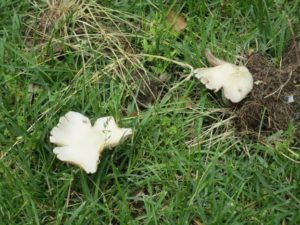
Mushrooms popping up post-rain in my backyard.
TURTLES AND MOUNTAIN LAUREL: Some Pine Barrens lore, “When the mountain laurel blooms, the snapping turtle lays its eggs.” Mountain laurel, “Kalmia latifolia,” is coming into bloom and, yes, snapping turtles, “Chelydra serpentina,” and other turtles are moving about. On Saturday, May 27, Priscilla “Peppy” Bath reported seeing a snapping turtle near her Mercer County home: “There was a huge turtle in the road. We stopped. Another car stopped and the turtle was not injured. But it was a big snapping turtle and the man was afraid to pick it up. Then, a young man on a bicycle came along and he picked it up and got it out of the road.” On the same day, I was driving on Route 206 in Burlington County and had to swerve to miss a box turtle, “Terrapene carolina carolina,” crossing 206. The car behind my Jeep hit it, but it appeared to nick it safely, knocking it to the side of the road. So, a heads-up while driving. If you move a turtle, move it in the direction it was traveling. If it is a snapper, I would use a shovel, not my hands. And, if using one’s hands, do not pick it up by its tail, which could injure it.
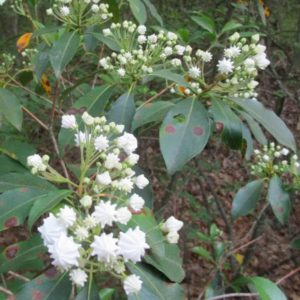
Mountain laurel about ready to go into full bloom at Jamesburg Park in the Pine Barrens around Helmetta.
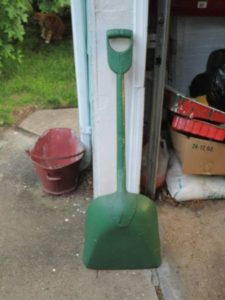
I keep this type of grain shovel in my Jeep to move snapping turtles off roads.
TREE MULCHING: I see so many examples of “volcano” mulching, or the wrong way to mulch a tree. Creating the volcano-look, or the pileup of mulch against a tree could cause too much wetness around the bark or make the tree susceptible to insect infestation or disease. Instead, use the “doughnut” method of placing the “doughnut hole” outside of the tree and its exposed roots, so the mulch is not touching bark. Outside of the hole, the mulch should be about only 2 or 3 inches in depth, so as not to overwet the tree. The outer rim of the “doughnut” should go to the end of the root ball or the tree canopy/drip line. If a tree is established, there is no need for mulching.
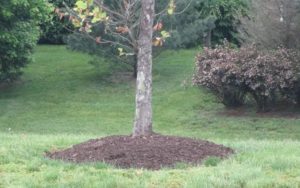
The mulch “volcano,” or the wrong way to mulch a tree, in South Brunswick, Middlesex County.
BLACKWELLS MILLS GARDENS: The gardens looked beautiful, here — in Franklin, Somerset County — which is part of Delaware and Raritan Canal State Park.
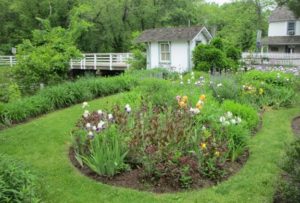
The garden at the circa 1830 bridge tender station at Blackwells Mills.
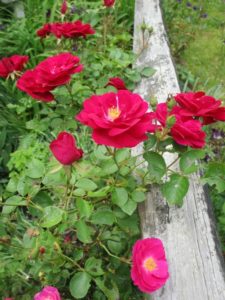
Flowers at Blackwells Mills.
MOON: The crescent moon waxes toward the June 9 Full Strawberry Moon.
GARDEN AND AFIELD: I already had some lower broom sedge, “Andropogon virginicus variety abbreviates,” gathered, here, in the Pine Barrens around Helmetta on display on my kitchen table. So, with my “Knock Out” Roses blooming, I just added some of those to the vase.
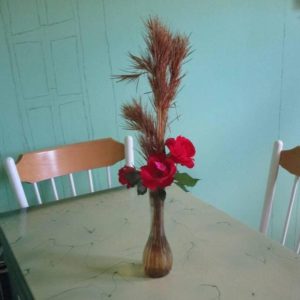
“Knock Out” Roses and lower broom sedge on my kitchen table.
SUNRISE/SUNSET: For the week of May 28, Sunday, to June 3, Saturday, the sun will rise about 5:30 a.m. and set about 8:20 p.m.
WEATHER: The National Weather Service forecasting station for the area is at http://www.weather.gov/phi/.
MY GARDEN: I am simply practicing the three Ws: Water, Weed, and Wait – waiting for lettuce, carrot, pea, sweet corn, tomato, mushmelon, cucumber, and zinnia to grow and be picked.
Joe Sapia, 60, is a lifelong Monroe resident. He is a Pine Barrens naturalist and an organic vegetable-fruit gardener.
He gardens the same backyard plot as did his Italian-American father, Joe Sr., and his Polish-immigrant, maternal grandmother, Annie Poznanski Onda. Both are inspirations for his food gardening. Joe is active with the Rutgers University Master Gardeners/Middlesex County program. He draws inspiration on the Pine Barrens around Helmetta from his mother, Sophie Onda Sapia, who lived her whole life in these Pines, and his Grandma Annie. Joe’s work also is at @JosephSapia on Twitter.com, along with Facebook.com on the Jersey Midlands page.
Article and photos by Joe Sapia
Note: The yard references are to my house in the section of Monroe between Helmetta and Jamesburg in South Middlesex County. My yard is in a Pine Barrens outlier on the Inner Coastal Plain, the soil is loamy, and my neighborhood is on the boundary of Gardening Zones 6b (cooler) and 7a (warmer). Afield references are to the Pine Barrens around Helmetta, unless otherwise noted. Photographs are for the period covered, unless otherwise noted.

Packets of some of the seeds I planted in my garden this year.
THE GARDEN: Shooting for May 20, I planted my garden pretty much on target, May 19 and 20, directly sowing Rutgers Heirloom Tomato, Heirloom Cucumber Straight Eight, Hale’s Best Jumbo Heirloom Cantaloupe, Northern Xtra-Sweet Hybrid (Sh2) Sweet Corn, and State Fair Mix Zinnia, all by Burpee, along with Cut and Come Again Zinnia by Agway. I started Red Cherry Tomato by Lake Valley Seed inside and transplanted them outside. Earlier in the season, I directly sowed cool-season crops: Salad Bowl Lettuce, Rainbow Blend Carrot, and Sugar Daddy Snap Pea, all the Lake Valley Seed brand. My garden is approximately 950 square feet, or about 315 row-feet. Now, it is the three Ws: Water (by 10 a.m. daily, unless the ground is wet), Weed, Wait.
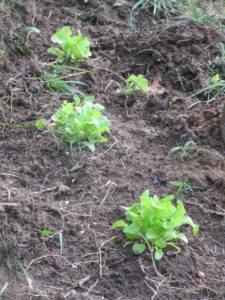
Lettuce growing nicely in my garden.
DEALING WITH MOTHER NATURE AND FATHER REALITY: I was planting the garden, working with no shirt on, when I finally paid attention to the buzzing around me. Ugh, bees! But I noticed they were not aggressive. I did some research and it appears my garden has beneficial ground bees, which will help with pollination. Thank you, Mother Nature. As for Father Reality, I had plowed areas for zinnias in the front yard and corn in a section of the backyard, only to find out contractors are ready to go on a house-remodeling project that has been planned for about two years. OK, no problem, I just re-grouped, abandoning plow lines too close to the house so as not to impede the work and plowed new lines. Father Reality turned out to be not so bad.
MOUNTAIN LAUREL AND TURTLES: Mountain laurel, “Kalmia latifolia,” is coming into bloom. With that, I recall some Pine Barrens lore: The snapping turtle lays its eggs when the mountain laurel blooms. Yep, there are reports of turtles moving around: snappers, “Chelydra serpentine”; painters, “Chrysemys picta”; boxers, “Terrapene Carolina.” If you move a turtle off a road, move it in the direction it was traveling. A water turtle is likely a female, either heading to high ground to lay eggs or returning to water after laying eggs. Safely moving snapping turtles: I use a shovel, preferably a wide grain shovel; I keep a grain shovel in my Jeep this time of year. More Piney lore: Only the setting sun or lightning makes the snapping turtle let go. A snapper’s chopped-off head will continue biting. Joey lore: If a snapping turtle will not let go, try shoving a wire up a nostril.
COLLIERS MILLS WMA: The state Colliers Mills Wildlife Management Area is about 13,000 acres in the Pine Barrens in Jackson and Plumsted, Ocean County. It basically runs from Six Flags Great Adventure in the north to Joint Base McGuire-Dix-Lakehurst in the south. Woods, fields, swamps, waterways, and bodies of water comprise the essentially undeveloped property. WMAs, or “game lands” as they are known elsewhere outside of New Jersey, basically are wildlife habitats and hunting grounds. Painted turtles, “Chrysemys picta,” basked. Yellow pond lilies, “Nuphar lutea,” were in bud. Pine Barrens hudsonia, “Hudsonia ericoides,” bloomed.

A painted turtle basks on Colliers Lake in the Colliers Mills Wildlife Management Area. Yellow pond lilies budding.
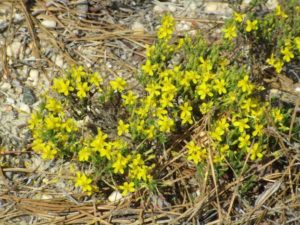
Pine Barrens hudsonia in bloom at the Colliers Mills WMA.
BEARS: Reports of roaming black bear, “Ursus americanus,” continue this spring. This week, there was a report of a bear in Millstone/Monmouth County. Stay clear and all should be all right. The bears are acting as bears do, looking for their own turf or to mate.
“KNOCK OUT” ROSES: My “Knock Out” roses started blooming. What a beautiful flowering addition to the yard. Other than trimming them, I do no maintenance on them. (They are thorny. Ask my foot. Foolishly walking barefooted last year, I stepped on a thorn, which stayed in my foot probably for weeks. I learned my lesson. I now wear shoes around the Knock Outs.)
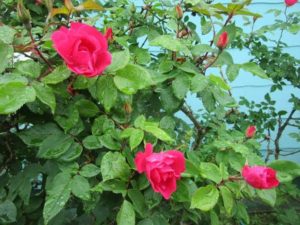
Knock Outs bloom in my backyard.
YARDWORK: On Wednesday, I trimmed the shrubs. At one point, I simply lifted my arm to trim some high shrubs and nearly went down on all fours with a pain in my left side/back. I hobbled to the house and lie down. Awakened Thursday, feeling better, and cut the lawn. On Friday, I prepared the garden and planted. On Saturday, I finished the planting. Feeling 60-years-old and beat up Saturday night!
BE ATTUNED TO NATURE: It is amazing how much of the natural world “happens” in front of us, rather than we having to go look for it. At Helmetta Pond, I watched a smaller bird harass a bigger bird, unfortunately too far away for me to identify. Standing in my backyard recently, I watched a black-colored bird harass a red-tailed hawk, “Buteo jamaicensis,” then I watched two red-tails circle around in the sky. And, as I have mentioned previously, I keep seeing a great egret, “Ardea alba,” fly by my house. So, keep an eye out.
PINK LADY-SLIPPER ORCHIDS: Seems to be a great year for pink lady-slipper orchids, “Cypripedium acaule.” I am seeing nice ones, here, in the Pine Barrens around Helmetta (and hearing of sightings in the main Pine Barrens). This week on a walk in the woods, I saw about 25, with about one-fifth blooming. In another spot, there were about 65. So, I saw almost 100.

Two blooming pink lady-slippers at Jamesburg Park in the Pine Barrens around Helmetta.
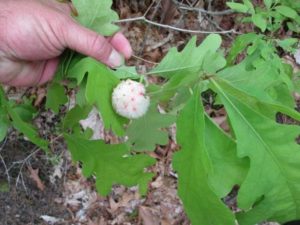
Pine Barrens around Helmetta – Gall of the wool-sower wasp, “Callirhytis seminator,” on a member of the white oak, genus “Quercus,” family. How to identify a member of the white oak family: Look at the round edges of the leaves, like bullets, rather than points, like arrows. Oaks with pointy leaves are members of the red oak family.
HUNTERDON COUNTY: Arguably New Jersey’s most beautiful county.

Green Sergeant’s Bridge, outside of Sergeantsville/Hunterdon County, the last remaining publicly owned covered bridge in New Jersey.
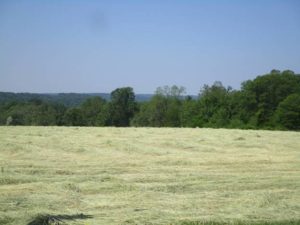
Cut hay in a field between Stockton and Sergeantsville/Hunterdon County.
BUTTERFLIES: For what it is worth, I have been seeing a lot of tiger swallowtails, “Papilio glaucus,” flying around.
SUNRISE/SUNSET: For the week of May 21, Sunday, to May 27, Saturday, the sun will rise about 5:35 a.m. and set about 8:15 p.m.
WEATHER: The National Weather Service forecasting station for the area is at http://www.weather.gov/phi/.
STAY ALERT: Stay alert with camera at the ready. There is a lot to see in garden and afield.

Pine Barrens “tea” water flowing over the spillway at Lake Success in the Colliers Mills Wildlife Management Area/Ocean County. Iron and vegetative matter color the water.
Joe Sapia, 60, is a lifelong Monroe resident. He is a Pine Barrens naturalist and an organic vegetable-fruit gardener.
He gardens the same backyard plot as did his Italian-American father, Joe Sr., and his Polish-immigrant, maternal grandmother, Annie Poznanski Onda. Both are inspirations for his food gardening. Joe is active with the Rutgers University Master Gardeners/Middlesex County program. He draws inspiration on the Pine Barrens around Helmetta from his mother, Sophie Onda Sapia, who lived her whole life in these Pines, and his Grandma Annie. Joe’s work is also at @JosephSapia on Twitter.com, along with Facebook.com on the Jersey Midlands page.
Article and Photos by Joe Sapia
Note: The yard references are to my house in the section of Monroe between Helmetta and Jamesburg in South Middlesex County. My yard is in a Pine Barrens outlier on the Inner Coastal Plain, the soil is loamy, and my neighborhood is on the boundary of Gardening Zones 6b (cooler) and 7a (warmer). Afield references are to the Pine Barrens around Helmetta, unless otherwise noted. Photographs are for the period covered, unless otherwise noted.
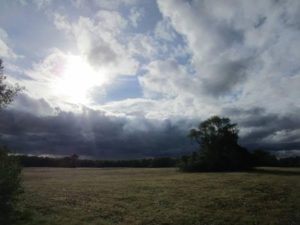
The Van Dyke Farm at Pigeon Swamp, South Brunswick/Middlesex County, where growing crops meets the woods.
VAN DYKE FARM: A favorite place to shoot photographs of mine is the Van Dyke Farm at Pigeon Swamp in South Brunswick/Middlesex County. It offers big-sky views to the west and the setting sun. See http://www.middlesexcountynj.gov/About/ParksRecreation/Pages/PR/VanDyke.aspx.
SOURLAND MOUNTAIN: I hiked one of my favorite Midlands places, Sourland Mountain on the boundary of Somerset, Hunterdon, and Mercer counties with a club I have been a member of for about 35 years, the Outdoor Club of South Jersey. On the mountain, I saw various flowers in bloom: showy orchid, “Galearis spectabilis,”; rue anemone, “Anemonella thalictroides”; and spring beauties, “”Claytonia virginica.” Being on the Piedmont with its rocky terrain, Sourland Mountain is much different than my generally flat and sandy Pine Barrens around Helmetta.
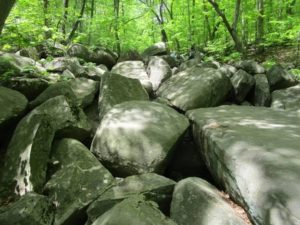
The Roaring Rocks boulder field on Sourland Mountain. Notice the hikers in the upper part of the photo.
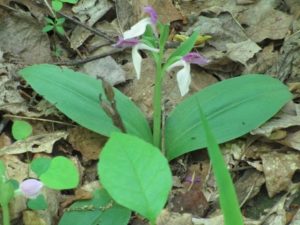
A showy orchid on Sourland Mountain
FLATLANDERS VERSUS HILLTOPPERS: For purposes of this writing, New Jersey has four geological areas, which run northeast to southwest: from west to east, Ridges and Valleys, Highlands, Piedmont, and Coastal Plain. (The Coastal Plain can be divided into two areas, Inner and Outer, making it five regions.) Generally, the Midlands are divided into the Piedmont and Coastal Plain, with distinct characteristics. The generally flat Coastal Plain has white, sandy soil (think Shore and Pine Barrens) and dark soil (think conventional farming areas). The rolling Piedmont has red shale and traprock boulders.
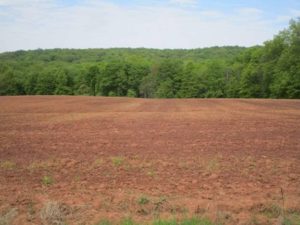
Piedmont red shale at Sourland Mountain, which is in the background.
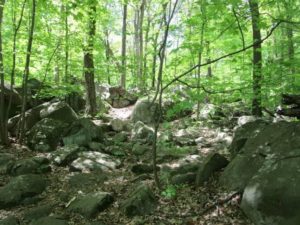
Traprock boulders on Sourland Mountain.
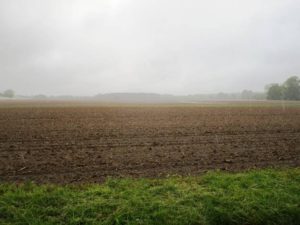
Coastal Plain dark soil at Cranbury/Middlesex County.
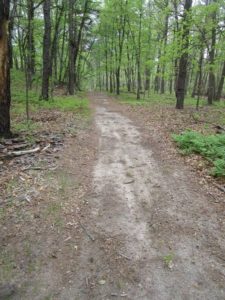
White, sandy soil in the Pine Barrens of Helmetta on the Coastal Plain.
FULL MOON AND PLANTING: The full moon was May 10, Wednesday, and some feel it is OK, now, to plant warm weather crops. Not me, especially with the cooler weather we have been having. I am still waiting for May 20 (if it warms up) to June 1 (if it remains on the cool side). Then, I will plant my warmer season crop – tomatoes, mushmellon, sweet corn, and cucumbers, along with zinnias to attract pollinators and for their beauty.
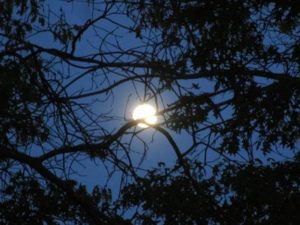
The near-Full Corn-Planting Moon. The full moon was Wednesday, May 10.
FOOD GARDEN: I weeded for the first time around the cool weather crops — “Salad Bowl” heirloom lettuce, “Rainbow Blend” carrots, and “Sugar Daddy” snap peas, all “Lake Valley Seed Company” brand — that have sprouted. I continue watering the garden.
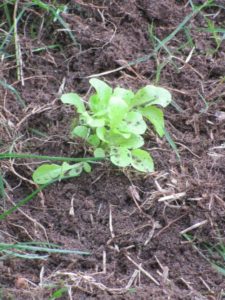
Lake Valley Seed Company “Salad Bowl” heirloom lettuce growing in my garden.
WATERING THE FOOD GARDEN: My goal is to give the food garden a thorough watering by 10 a.m. This allows the garden to retain water, rather than have the water evaporate in the heat of day, and allows the garden to dry by the dewy nightfall to prevent fungal growth.
KEEPING WILDLIFE AWAY, CAYENNE PEPPER: I was talking a waitress at the Dayton Diner in South Brunswick/Middlesex County. An experienced gardener, she recommended using cayenne pepper as a method of pest control around the garden. I plan on trying that.
ALONG THE SOUTH RIVER: My travels took me across the South River at Old Bridge village on the boundary of Old Bridge, Sayreville, and East Brunswick, all in Middlesex County. On my way back, I stopped to shoot photographs between Old Bridge village and the New Causeway on the boundary of South River and Sayreville, both in Middlesex County. The South River is formed by the meeting of Manalapan and Matchaponix brooks on the Spotswood-Old Bridge boundary at DuHerNaL Lake/Middlesex County. (DuHerNaL Lake gets its name from the three companies that had used it as a reservoir: DuPont, Hercules, and National Lead.) Normally, I do not think of inland self, 25 or so miles from the Atlantic Ocean, living near salt water, but the tidal effect begins at the bottom of the DuHerNal Lake dam, only a little more than 4 miles from my house.
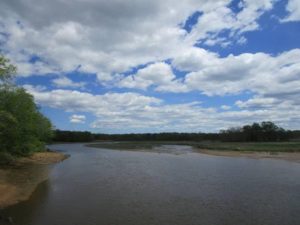
The South River at low tide at Old Bridge village.
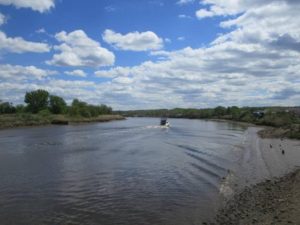
The South River at low tide at the New Causeway on the South River-Sayreville boundary. This scene looks upstream toward the railroad bridge and the South River Boat Club — Sayreville on the left, South River on the right.
KILLDEER: When I was at the South River at Cannon Brothers Park in South River, I spooked a killdeer, “Charadrius vociferous.” The species screeches a “kill-deer” call. Because of the way the bird was acting, panicked but not leaving the area, I suspect it had a nest nearby it was trying to divert me from. An adult killdeer will even fake a broken wing to get a predator to follow it, rather than have the predator attack the ground nest. I could not find a nest.
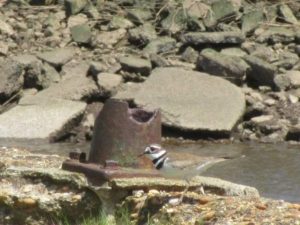
A killdeer along the South River in South River.
TURKEYS: Some thoughts from Bob Eriksen, the retired state turkey biologist, on “Meleagris gallopavo,” “…Wild turkeys that have adapted to suburbia will sometimes nest in among shrubs in a yard. I had one nest next to a gravestone in a cemetery. Most of the time turkey nests are in the woods or in an overgrown field. Hens will tuck in next to a tree trunk, at the base of a shrub, or in a blowdown, especially if there is a branch within a few feet. They like to have a bit of overhead cover. Once the grass in hayfields is tall enough to hide the hen crouched down (usually second week of May), a hen turkey will nest in a hayfield. Cover is the main consideration. Hens are pretty secretive approaching the nest. They may circle or use different approaches when they go to the nest to lay. When the clutch is large enough (10-12 eggs), she will begin to incubate. For the first couple of nights after she has completed her clutch, she may tree roost, but that changes fast. Once incubation begins, the hen will be on the nest 20 or more hours a day.” (A shout out to Bob for always being so helpful.)
JERSEY MIDLANDS LORE: Another good source of information is legendary Helmetta outdoorsman Ralph “Rusty” Richards, 84-years-old. During one of our occasional breakfasts of members of 100-year Helmetta families, Rusty was talking about deer-hunting. In the early part of the 20th Century, white-tailed deer, “Odocoileus virginianus,” were almost gone from New Jersey because of over-hunting. As the state brought them back, they gradually re-settled. About 1950, they were in the Broadway Woods area of South Brunswick/Middlesex County, only a few miles from Helmetta, according to Rusty. Then, about 1955, they were settled around Helmetta, Rusty said.
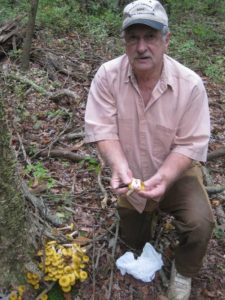
In 2011, Rusty Richards with “opienki” mushrooms, genus “Armillaria,” in the Pine Barrens around Helmetta.
BOBWHITE: Did I hear a bobwhite quail, “Colinus virginianus,” calling in my neighborhood? If so, it would have been a return to my childhood when one could hear the “Bob White” call at night. Bobwhites have become rare in New Jersey because of habitat loss, but, in recent years, there has been an effort to welcome them back. So, was it a wild bobwhite or not? I do not know….
TICKS: Reports are still coming in on how bad a tick season it is.
I am hearing reports of deer ticks, “Ixodes scapularis,” and lone star ticks, “Amblyomma americanum.” Various reasons may be causing the problem, including warm weather generating acorn growth and, in turn, the acorns providing abundant food to tick-carrying animals, along with the recent rainy weather. “More rain typically enhances tick season,” said meteorologist Steve DiMartino.
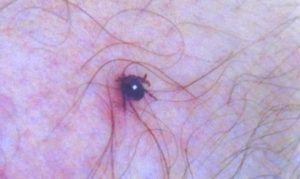
A lone star tick on my leg. Lone star ticks are easily identifiable by the yellow dot on their backs.
PINE BARRENS AROUND HELMETTA: Pink lady-slipper orchids, “Cypripedium acaule,” continue to bloom. I know of a spot that has about 75 lady-slippers, with about five in bloom. If you see a pink lady-slipper, look around for more in the area; I see them in clusters. And do not pick them!
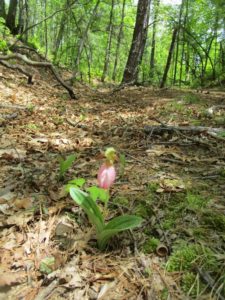
A blooming pink lady-slipper orchid, with another, left and to the rear of the blooming orchid, poking through the ground.
SUNRISE/SUNSET: For the week of May 14, Sunday, to May 20, Saturday, the sun will rise at about 5:40 a.m. and set at about 8:10 p.m.
WEATHER: Go to the National Weather Service forecasting station for the area, http://www.weather.gov/phi/.
THE END-OF-THE-WEEK RAIN: I look to a thorough rain around May 15 to green up the woods for the season. The steady, heavy rain of Saturday, May 13, should have accomplished that. By late Saturday night as the rain continued, my rain gauge showed 2.3 inches.
WEATHER: Go to the National Weather Service forecasting station for the area, http://www.weather.gov/phi/.
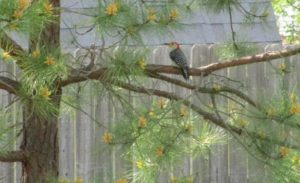
A red-bellied woodpecker, “Melanerpes carolinus,” sitting in a pitch pine, “Pinus rigida,” in my backyard.
Joe Sapia, 60, is a lifelong Monroe resident. He is a Pine Barrens naturalist and an organic vegetable-fruit gardener.
He gardens the same backyard plot as did his Italian-American father, Joe Sr., and his Polish-immigrant, maternal grandmother, Annie Poznanski Onda. Both are inspirations for his food gardening. Joe is active with the Rutgers University Master Gardeners/Middlesex County program. He draws inspiration on the Pine Barrens around Helmetta from his mother, Sophie Onda Sapia, who lived her whole life in these Pines, and his Grandma Annie.
Article and photos by Joe Sapia
Note: The yard references are to my house in the section of Monroe between Helmetta and Jamesburg in South Middlesex County. My yard is in a Pine Barrens outlier on the Inner Coastal Plain, the soil is loamy, and my neighborhood is on the boundary of Gardening Zones 6b (cooler) and 7a (warmer). Afield references are to the Pine Barrens around Helmetta, unless otherwise noted. Photographs are for the period covered, unless otherwise noted.
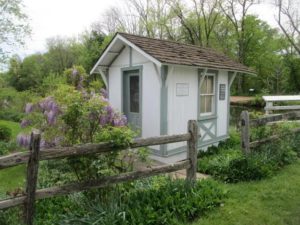
In the Delaware and Raritan State Park, the historic bridgetender station, circa 1830, and garden at Blackwells Mills in Franklin/Somerset County.
GARDEN AND YARD: In my food garden, peeking through the soil are cool weather vegetables of lettuce and carrots. I had not seen any noticeable sign of peas coming up, but Cranbury/Middlesex County farmer Roy Reinhardt advised me to be patient; He was right, there they were a few days later. Wild onions, “Allium canadense,” are coming up in my lawn; If only I enjoyed onions more than I do, I would have a nice bounty.

Wild onions growing in the yard.
RAIN: The rain May 5, Friday, was drenching. Kathy Krygier of Krygier’s Nursery in South Brunswick/Middlesex County reported about 1.75 inches. Other reports from the Jersey Midlands, via the wunderground.com website, include Lambertville/Hunterdon County, 1.63 inches; Somerville/Somerset County, 1.16 inches; the Mill Lake Manor section of Monroe, 2.05 inches; Little Silver/Monmouth County, 2.02 inches; Miller Air Park in Berkeley/Ocean County, 2.63 inches; the Chatsworth area/Burlington County, 1.62 inches; and Ewing/Mercer County, 1.63 inches.
UPCOMING FOOD GARDEN DATES: For planting the warm season crop, my rule of thumb is May 20 (in a warm season) to June 1 (in a cooler season), with steady overnight temperatures of 55 or higher. Some planters go by Mother’s Day (this year, May 14), some go by May 15. Helmetta farmer Timmy Mechkowski says after the May full moon – this year, this Wednesday, May 10, the Full Corn-Planting Moon.
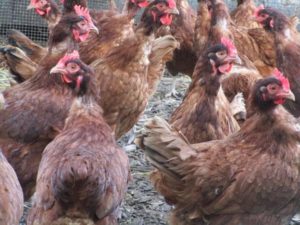
Rhode Island red chickens at the Mechkowski Farm in Helmetta.
INTERNATIONAL SPACE STATION: Possible sightings of the ISS are May 8, Monday, 4:47 a.m. to 4:50 a.m, tracking west southwest to north northeast; May 9, Tuesday, 3:57 a.m. to 3:59 a.m., south to east northeast; May 10, Wednesday, 4:40 a.m. to 4:44 a.m., west to north northeast; May 12, Friday, 4:32 a.m. to 4:36 a.m., west northwest to north northeast. Caution: One needs a clear sky and, at times, a clear view well above the horizon.
EGRET: I have noticed a great egret, “Ardea alba,” fly by my house two or three times in recent weeks, along with once about 1-1/2 miles away. I suspect it is the same bird. Just an interesting sighting.
TURKEY: A wild turkey, “Meleagris gallopavo,” greeted me when I turned onto my street.

A wild turkey in the neighborhood.
TICKS: Reports are coming in about ticks being out with a vengeance in New Jersey. I, for example, have pulled deer ticks, “Ixodes scapularis,” and lone star ticks, “Amblyomma americanum,” off my clothes. From Chris Bevins, “How are you making out with ticks? They are ferocious this year and first time I’m seeing lone star ticks in abundance.” And Frank Ulatowski says he had about a dozen on him or his clothes after being up at the Delaware Water Gap area.
PINE BARRENS AROUND HELMETTA: Pink lady-slipper orchids, “Cypripedium acaule,” are coming into bloom. Flowering dogwood, “Cornus florida,” remains in bloom. Pitch pine, “Pinus rigida,” have long “candles” of new growth. Cinammon fern, “Osmunda cinnamomea,” is in its fiddlehead state and unfurling. Northern gray treefrogs, “Hyla versicolor,” continue calling vociferously. Spring peeper treefrogs, “Pseudacris crucifer,” continue calling. Sunfish, genus “Lepomis,” guarded their nests at Helmetta Pond. Antlion larvae, “Hesperoleon abdominalis,” had pits to capture ants. And I captured a nice photo of some kind of dragonfly in the woods.
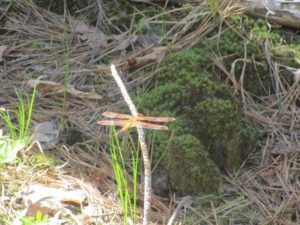
A dragonfly at Jamesburg Park/Middlesex County.
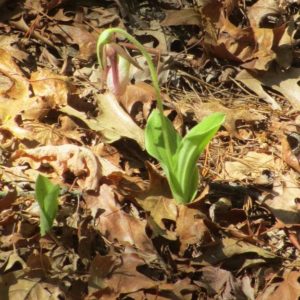
A pink lady-slipper orchid in bloom, right. Left, lady-slipper leaves poking through the ground.
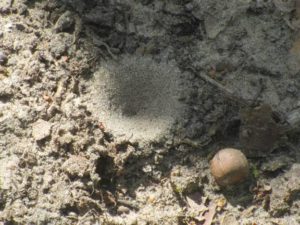
The pit of an antlion larva, or doodlebug. The larva sits in a pit awaiting a meal of an ant. The larva eventually evolves into a flying insect. To put the size of the pit in perspective, that is an acorn sitting nearby.
DELAWARE AND RARITAN CANAL: I visited a Franklin/Somerset County section of the D&R Canal State Park, specifically the area between Route 518 and Blackwells Mills. Various animals were active — great blue heron, “Ardea herodias”; Gray catbird, “Dumetella carolinensis”; redbelly turtles, “Pseudemys rubriventris.” Spring beauties, “Claytonia virginica,” remain in bloom. I saw as-big-as-my-forearm poison ivy, “Toxicodendron radicans” — “Hairy rope, don’t be a dope!” As a kid, I could touch it and not get a rash, but twice I got it bad as an adult years ago — perhaps it was because of the hot days, me sweating, my pores open. Now, I take no chances!
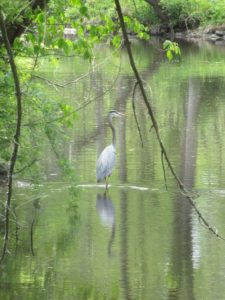
A great blue heron in the D&R Canal.
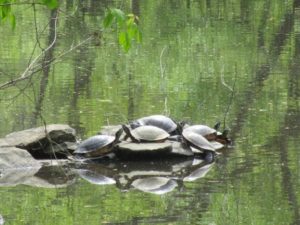
Basking redbelly turtles in the D&R Canal.
TURTLES CROSSING ROADS: A heads-up for turtles crossing roads. There has been a lot of reported movement lately. If driving, watch out for them. If trying to move them, one, do it safely and, two, move the turtle in the direction it was traveling. (For snapping turtles, “Chelydra serpentina,” BE CAREFUL. Some Piney lore, only lightning or the setting sun will make a snapper let go. Me, I use a grain shovel I keep in my Jeep to move snappers across roads.) I was driving through Pigeon Swamp in South Brunswick/Middlesex County recently and saw what I think was an eastern painted turtle, “Chrysemys picta,” crossing a road. By the time I turned around to move it, it was gone.
SUNRISE/SUNSET: For the week of May 7, Sunday, to May 13, Saturday, the sun will rise at about 5:45 a.m. and set at about 8:05 p.m.
WEATHER: Go to the National Weather Service forecasting station for the area, http://www.weather.gov/phi/.
UPCOMING AFIELD DATE: The first soaking rain around May 15 should green up the woods for the season.
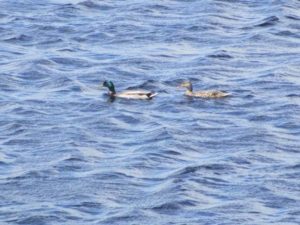
Mallards, “Anas platyrhynchos,” at Helmetta Pond. Left, the colorful male, and, right, the more drabby, brown female.
Joe Sapia, 60, is a lifelong Monroe resident. He is a Pine Barrens naturalist and an organic vegetable-fruit gardener.
He gardens the same backyard plot as did his Italian-American father, Joe Sr., and his Polish-immigrant, maternal grandmother, Annie Poznanski Onda. Both are inspirations for his food gardening. Joe is active with the Rutgers University Master Gardeners/Middlesex County program. He draws inspiration on the Pine Barrens around Helmetta from his mother, Sophie Onda Sapia, who lived her whole life in these Pines, and his Grandma Annie.
Article and photos by Joe Sapia
Notes from Garden and Afield in the Jersey Midlands
“From the Raritan River to the Mullica River, From the Delaware River to the Atlantic Ocean….”
Week of 2017, April 23, Sunday, to April 29, Saturday
Note: The yard references are to my house in the section of Monroe between Helmetta and Jamesburg in South Middlesex County. My yard is in a Pine Barrens outlier on the Inner Coastal Plain, the soil is loamy, and my neighborhood is on the boundary of Gardening Zones 6b (cooler) and 7a (warmer). Afield references are to the Pine Barrens around Helmetta, unless otherwise noted.
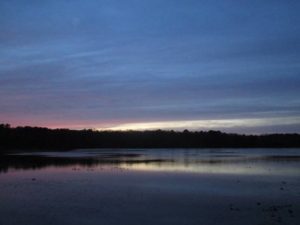
Helmetta Pond at dusk
PINE BARRENS AROUND HELMETTA: Flowering dogwoods, “Cornus florida,” are flowering. Pitch pines, “Pinus rigida,” have their “candles,” or new growth. Northern gray treefrogs, “Hyla versicolor” and northern spring peeper treefrogs, “Pseudacris crucifer crucifer,” are calling.
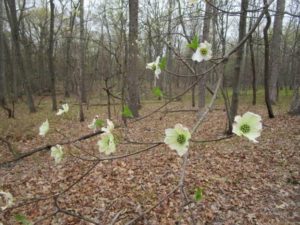
Flowering dogwoods in the Pine Barrens around Helmetta, specifically in an East Brunswick section of the Jamesburg Park Conservation Area.
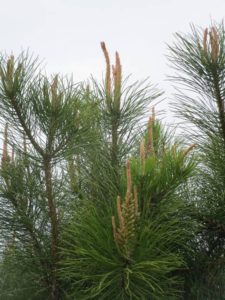
“Candles,” or new growth, on a pitch pine in the Pine Barrens around Helmetta.
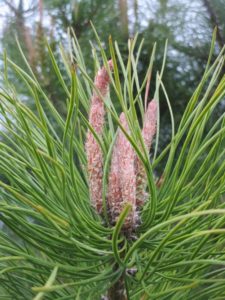
“Candles,” or new growth, on a pitch pine in the Pine Barrens around Helmetta.
SOURLAND MOUNTAIN WILDFLOWERS: This week, I drove the Piedmont geologic formation from the Delaware River in Hunterdeon County to its meeting the Inner Coastal Plain in South Middlesex County. When I crossed Sourland Mountain on the boundary of Hunterdon, Mercer, and Somerset counties, I saw spring beauties, “Claytonia virginica,” in bloom. Mayapples, “Podophyllum peltatum,” were “umbrella-ing,” their leaves in umbrella-like formation. Mayapples should be blooming about this time, although I did not notice any flowering.
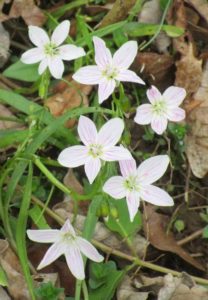
Spring beauties on Sourland Mountain
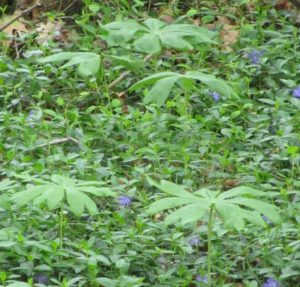
Mayapples, in their umbrella look, on Sourland Mountain.
TICKS: Ticks are out. While in the woods, I have pulled deer ticks, “Ixodes scapularis,” and a lone star tick, “Amblyomma americanum,” off my clothes.
IN MY GARDEN: Lettuce is sprouting, but I still await carrots and peas.
GARDEN FLOWERING IN LAMBERTVILLE: Ornamental flowers were flourishing in Lambertville, making the town more beautiful than it already is.
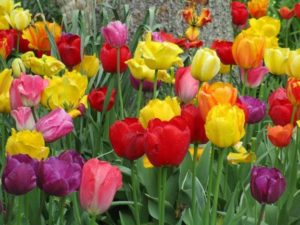
Flowers in Lambertville.
SHAD ON THE DELAWARE RIVER: In talking to Lambertville locals April 28, the peak of the American shad, “Alosa sapidissima,” migration up the Delaware River had already passed. But shad were still around – and the Shad Fest wraps up April 30.
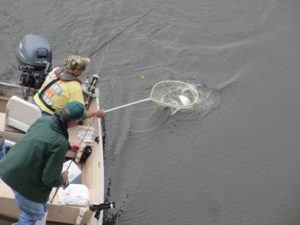
Catching shad on the Delaware River.
SNOWFALL FOR 2016-2017: The season ended with 26.5 inches of snow, the last snowfall on March 15. In terms of total snowfall, this was right about average. (The measurements were at my home and the average snowfall figure would be for my area. These recordings are unofficial.)
SUNRISE/SUNSET: For the week of April 30, Sunday, to May 6, Saturday, the sun will rise at about 5:50 a.m. to 6 a.m. and set at about 7:50 p.m. to about 8 p.m.
WEATHER: Go to the National Weather Service forecasting station for the area, http://www.weather.gov/phi/.
DATES TO KEEP IN MIND: For the woods, the first drenching rain around May 15 should green up the woods. For the food garden, my rule of thumb is to plant warm weather vegetables and fruits about May 20 if the weather has been warm and June 1 if the weather has been cool – Look for consistent overnight temperatures of 55 or warmer.
Joe Sapia, 60, is a lifelong Monroe resident. He is a Pine Barrens naturalist and an organic vegetable-fruit gardener.
He gardens the same backyard plot as did his Italian-American father, Joe Sr., and his Polish-immigrant, maternal grandmother, Annie Poznanski Onda. Both are inspirations for his food gardening. Joe is active with the Rutgers University Master Gardeners/Middlesex County program. He draws inspiration on the Pine Barrens around Helmetta from his mother, Sophie Onda Sapia, who lived her whole life in these Pines, and his Grandma Annie.
Article and Photos by Joe Sapia

Turning over the vegetable garden
Author’s note: The yard references are to my house in the section of Monroe between Helmetta and Jamesburg in South Middlesex County. My yard is in a Pine Barrens outlier on the Inner Coastal Plain, the soil is loamy, and my neighborhood is on the boundary of Gardening Zones 6b (cooler) and 7a (warmer).
MESSING UP PREPPING THE VEGETABLE GARDEN: To get a jump on the vegetable garden, I sowed inside early season plant seeds of lettuce, carrots, and peas. That was a mistake. When I was transitioning them to plant outside, I killed them. I should have waited and planted them directly into the garden. So, I had to regroup….
…PLANTING THE EARLY SEASON GARDEN: I bought new seeds – “Salad Bowl Green Heirloom Lettuce,” “Rainbow Blend Carrots,” and “Sugar Daddy Snap Peas,” all Lake Valley Seeds brand – and planted the early spring garden April 8.
NEXT UP AT THE GARDEN: I will plant the summer crops – sweet corn, tomatoes, cantaloupe, and cucumbers, along with zinnias for color and to attract pollinators – roughly May 20 (if the weather has been warm) to June 1 (if the weather has been cool).
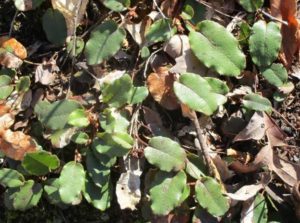
Unflowering trailing arbutus, or “May pink.”
FLOWERING IN THE WOODS: Swamp maples have their red tinge of buds, along with the budding of “May pinks” (trailing arbutus). I saw a report trailing arbutus has already flowered in the main Pine Barrens to the south, but have not seen any beyond budding in the Pine Barrens around Helmetta.
BIRDS SINGING SPRING SONGS: I am hearing the birds beginning their daily singing about 6 a.m. to 6:15 a.m., or about 15 to 40 minutes before sunrise. The birds presumably are singing to assert territory and to attract mates.
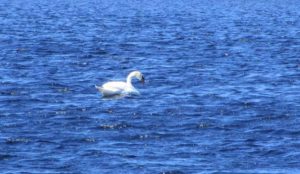
A beautiful, but invasive, mute swan at Helmetta Pond
“POND PIGS” AT HELMETTA POND: While beautiful, mute swans are a non-native bird that have been naturalized in America – and are disrupting the natural world around them. They are aggressive to humans and animals and deplete food supplies. There were brought to this country from Europe in the late 1800s and early 1900s.
LAST SNOW OF THE SEASON: Since the winter of 1995-1996, it has snowed as late as April 16 (April 9-10 for accumulating snow). Judging from the upcoming weather forecast, we probably had our last snow of the season, which was March 15.
OCCASIONAL LOUDNESS OF THE NEW JERSEY TURNPIKE: Wonder why the sound of the Turnpike is very loud at times, well beyond the quiet background noise? Probably because of warmer temperatures in the air compared with colder ones at the ground level.
GREEN WATERING OF THE GARDEN: Last year, I used a combination of drinking water from the house spigot and “gray” water (used bathing water). I got thinking about conserving house water – or even more conservation than I already do – and not putting soapy bath water into the garden. So, this year, 1. I am going to try using more accumulated rain water, making sure I keep the barrel covered when not in use so as not to promote mosquito breeding; 2. I am going to try to use available fresh water, perhaps from Manalapan Brook and a nearby swamp.; and 3., Conserve even more water at home. (In the 15 years since I have been taken over the family house, I have cut water usage by up to about 50 percent, the results of a bathroom renovation and conservation.
SUNRISE/SUNSET for April 2 to 8: Roughly about 6:20 to 6:30 Eastern Daylight Time for sunrise and about 7:30 to 7:35 for sunset.
VIEWING THE INTERNATIONAL SPACE STATION: The ISS may be visible Tuesday, April 11, 8:16 p.m. to 8:21 p.m., from north northwest to east; Friday, April 14, 8:53 p.m. to 8:56 p.m.; and Saturday, April 15, 8:02 p.m. to 8:06 p.m.
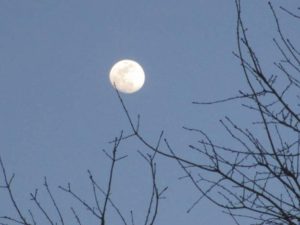
The near-full moon over Manalapan Brook in Monroe
NIGHT SKY: The Full Sprouting Grass Moon is on the Monday-Tueday, April 10-11, overnight. Also, see http://earthsky.org/tonight.
DROUGHT: With the recent rains, drought concerns may be lifted in the coming days by the state Department of Environmental Protection.
— Joseph Sapia
2017, April 9, Sunday,
Joe Sapia, 60, is a lifelong Monroe resident. He is a Pine Barrens naturalist and an organic vegetable-fruit gardener. He gardens the same backyard plot as did his Italian-American father, Joe Sr., and his Polish-immigrant, maternal grandmother, Annie Poznanski Onda. Both are inspirations for his food gardening. He draws inspiration on the local Pine Barrens from his mother, Sophie Onda Sapia, who lived her whole life in the local Pines, and his grandmother.
Article and photos by Joe Mish
RAINFALL: It rained about 2.5 inches in the New Brunswick-Trenton area at the end of last week. So, it will be interesting to see what this week’s drought maps say.
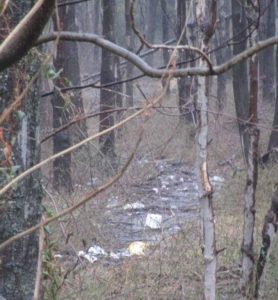
Garbage floating in a Monroe, Middlesex County, drainage ditch
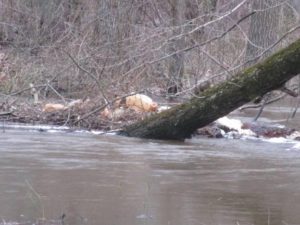
Garbage caught on a tree snag
in Manalapan Brook, Monroe, Middlesex County
NON-POINT SOURCE POLLUTION: During and after the week’s rains, the flow of non-point source pollution was obvious in our waterways. The cost-free way of dealing with it is, do not litter and do not leave stuff out in the yard, then it will not float into waterways.
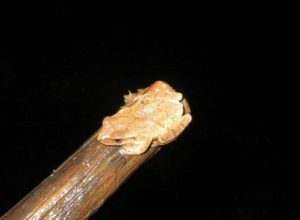
A spring peeper treefrog, found in the Manalapan Brook floodplain
FROGS: I walked into the swamp hardwood forest of the Manalapan Brook floodplain between Helmetta and Jamesburg early in the week. The sleigh bells-like sound of spring peeper treefrogs, “Pseudacris crucifer crucifer,” was obvious. I also heard monkey chattering-like sound of wood frogs, “Rana sylvatica.”
RASPBERRIES: I planted five bare-root Burpee seed company Caroline raspberry plants.
GARDEN ZONES: Depending on the source, the area is Garden Zone 6 (cooler) to Garden Zone 7 (warmer). That means our last frost generally is April 15 to 30; Our first frost is generally Oct. 11 to 20. Beyond that, I am playing it safe and sticking with Zone 6 for my Helmetta area, Middlesex County, home, although the area becoming a solid Zone 7 because of global warming is likely just around the corner.
OUTDOOR PLANTING FOR SUMMER VEGETABLES AND FRUITS: My rule of thumb is May 20 if it is a warm to normal and, if it is cooler, wait to June 1.
PREPARING PLANTS INDOOR: This year, though, I am trying something new, sowing plants indoors before the outside plant dates. So, I am experimenting with Kaleidoscope Blend Organic and Touchon carrots, Iceberg A lettuce, and Sugar Snap peas, all Burpee, which I began sowing about March 5. I added Rutgers tomatoes about March 25. I plan on sowing more tomatoes – Brandywine Red and Red Cherry, both Lake Valley brand – indoors in the next day or so.
HUMMINGBIRDS: Get the hummingbird feeders up by about April 15 to attract the early “scout” birds and they hopefully will lead later-arriving hummingbirds to the feeders.
NIGHT SKY: http://www.skyandtelescope.com/observing/sky-at-a-glance/this-weeks-sky-at-a-glance-march-31-april-8/.
SUNRISE/SUNSET: Approximate times are April 2, Sunday, 6:40 and 7:23 Eastern Daylight Time; April 3, Monday, 6:38 and 7:25; April 4, Tuesday, 6:36 and 7:26; April 5, Wednesday, 6:35 and 7:27; April 6, Thursday, 6:33 and 7:28[ April 7, Friday, 6:31 and 7:29; an April 8, Saturday, 6:30 and 7:30.
WEATHER: Local weather forecasts are available at http://www.weather.gov/phi/.

Carnegie Lake near the Kingston dam
on the boundary of Mercer, Middlesex, and Somerset counties
Joe Sapia, 60-years-old, grew up and lives in the Pine Barrens around Helmetta, where his family has resided for more than 100 years. He can be reached at Snufftin@aol.com or at P.O. Box 275, Helmetta, 08828.
Article and photos by Joseph Sapia
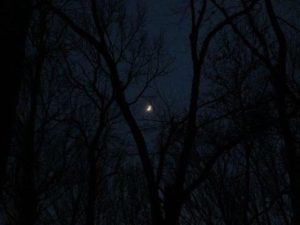
Above the Manalapan Brook floodplain, a crescent moon waxed toward December’s Full Long Nights Moon
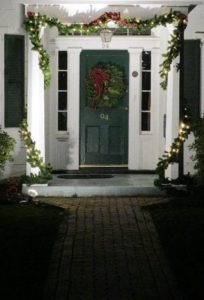
Christmastime in Fair Haven, Monmouth County
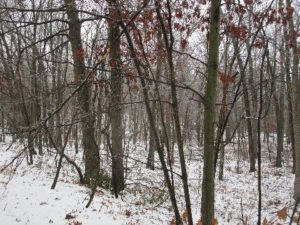
Snowfall of 1-1/2 inches December 17 in the Jamesburg Park Conservation Area, Middlesex County
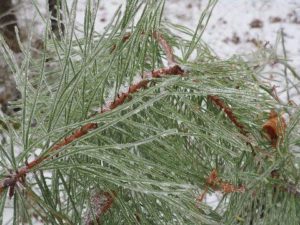
Ice builds up on the needles of a pitch pine, Pinus rigida, the common tree of the New Jersey Pine Barrens. Here, in the Jamesburg Park Conservation Area in the Pine Barrens around Helmetta.
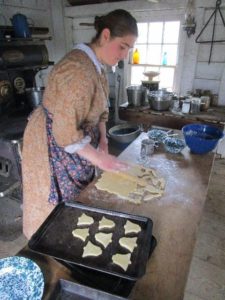
Christmastime at historic Longstreet Farm, the Monmouth County Park System’s living history farm, replicating the late 1800s in Holmdel. Here, baking cookies the old-fashioned way.
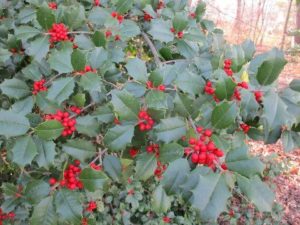
Holly in my neigbhorhood in Monroe, Middlesex County.
Joe Sapia, 60-years-old, grew up and lives in the Pine Barrens around Helmetta, where his family has resided for more than 100 years. He can be reached at Snufftin@aol.com or at P.O. Box 275, Helmetta, 08828.
Article and photos by Joseph Sapia

Shekiro’s Pond in Helmetta
Joey Slezak grew up in South Jersey, but he has multi-generational roots in the Pine Barrens around Helmetta and has lived in his parental grandparents’s former house in Helmetta while studying at Rutgers University in New Brunswick. In his own right, Joey is a meteorology student at Rutgers, an outdoorsman, and, importantly to me in the outdoors, my go-to science guy.
I was looking forward to walking afield with him – perhaps not on as cold a day as February 18, 2015. Minus 1 degree at dawn and 9 degrees when I left my house about two hours later. But between our schedules, we had to take advantage of this opportunity, cold or not. Plus, we are woodsmen from Helmetta of tough local Polish stock. So, we plunged into the approximately 15 degrees when we finally started walking before 10 a.m.
A woodpecker hammered away. A few inches of snow covered the ground – on the surface, it was fluffy — and clung to trees.
“You could see the snow fall from the trees, these little flakes go by,” said Joey, 22-years-old at the time and working on his bachelor’s degree in meteorology.
On this day, we would spend much time in wetlands, including an Atlantic white cedar swamp being threatened by invasive phragmites.
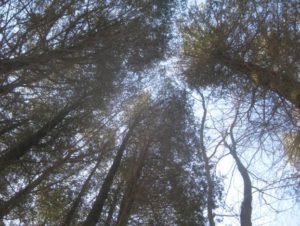
Looking skyward from the Atlantic white cedar swamp
“This is probably as secluded as you could be in these woods,” I said.
It was very quiet, until a jet airplane flew by.
“The final approach to Newark Airport comes over us,” Joey said.
Despite the cold, I was surprisingly warm.
“Once you heat up your clothes, there’s no wind to dissipate it,” Joey said. “(And) you’re dressed for it.”
I was dressed in long underwear, bottoms and tops; covered with a sweater and windbreaker jacket, all made of materials to wick sweat.
Joey pointed out hoar frost, a crystallized coating of frost. With the hoar frost, Mother Nature worked her art on any icy surface of water and on blades of vegetation.

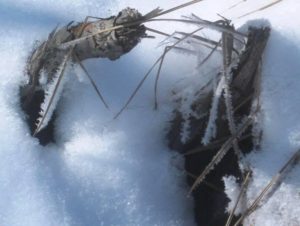
Mother Nature’s artwork: hoar frost.
Here and there, we were in danger of breaking through the swamp ice. I went up to my shins at one point, up to my thigh at another. Joey noted how he could smell the swamp when I broke through.
As we walked, we noticed evidence of the day’s low humidity – in the clarity and blueness of the sky.
“Not a cloud in the sky (hardly), a bluebird day,” said Joey, who, now in 2017, is working on his master’s degree in atmospheric science.
As we walked a sand road, we noticed fallen trees, lying northeast to southwest.
“That’s probably coastal,” Joey said, meaning a storm out of the east, rather than in the normal flow of wind from the west.
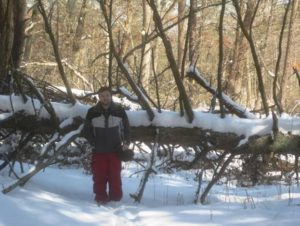
Joey Slezak at a treefall.
Perhaps the highlight of the day was hearing the call – a running-a-finger-along-the-teeth-of-a-comb sound — of a New Jersey chorus frog. This frog is an early caller, breeding as early as February, according to New Jersey Division of Fish and Wildlife literature.
“That sun’s getting warm,” Joey said.
By the time we ended the walk at lunchtime, the temperature was about 30.
“I had a lot of work to do, a lot of stress,” Joey said. “It felt pretty good to get out there.”
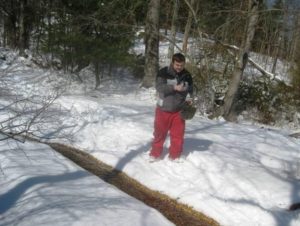
Joey Slezak at a small stream
Joe Sapia, 60-years-old, grew up and lives in the Pine Barrens around Helmetta, where his family has resided for more than 100 years. He can be reached at Snufftin@aol.com or at P.O. Box 275, Helmetta, 08828.
by Joseph Sapia
Gardening: In Helmetta, Monroe, and Jamesburg
2016, August 7, Sunday, to August 13, Saturday
The gardening and yard references are to my house in the section of Monroe between Helmetta and Jamesburg in South Middlesex County. My yard is in a Pine Barrens outlier on the Inner Coastal Plain, the soil is loamy, and my neighborhood is on the boundary of Gardening Zones 6b and 7a.
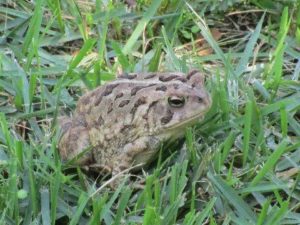
Fowler’s Toad
HARVESTING: Cucumbers. Picked a cantaloupe, but I should have waited. So, holding off on picking more cantaloupes.
TO HARVEST OR NOT TO HARVEST: My tomatoes are not moving – they are not growing and ripening, plants are dying. I think the wildlife has been getting to them….
THE LAWN: Because of work and the weather not cooperating on my days off (that is, either raining or threatening thunder storms with lightning), I got way behind on cutting the grass. So,…
CUTTING THE GRASS IN THE HEAT: I jumped on a sunny, day-off opportunity to cut the lawn – in 95 degrees with a heat index of 114 degrees. I wet my straw hat, stayed hydrated by drinking plenty of water, and took breaks. It was a grind for this old (59) boy. Three wet T-shirts and one fear-of-lightning break later, I finished the backyard.
CUTTING DOWN THE GARDEN: I mowed over the area where the lettuce had been planted – and, now, considering planting a late crop of lettuce. I also mowed down for the most part the done-producing corn stalks.
WILDLIFE IN THE YARD: The raccoons continue to topple the bird-feeder if I do not get it in the garage early enough at night. And I came across a Fowler’s toad — easily identifiable by the several warts in the splotches –while cutting the lawn. And, yes, the toad urinated when I caught him. I let him go in one of the high-grass wildlife patches I keep in the yard. (Photo of the Fowler’s toad.)
ROSE THORN IN MY FOOT: Despite wearing sneakers, I got a rose thorn in the big-toe area of my right foot. Pulled that sucker out fully. Not like the thorn or whatever that I have/had stuck in the ball of my left foot for about three weeks. Just keeping an eye on it, making sure it is not infected, waiting for it to work itself out.
MOSQUITOES: NJ has had at least three cases of West Nile virus in humans – one in Camden County, according to the state; two in Monmouth County (Atlantic Highlands and the Spring Lake area), according to the county. I checked a barrel I keep with a combination of rain, gray water, and de-humidifier water and found mosquito larvae in it. So, I emptied some of it and put a top on the barrel of the remainder. Interestingly, I cannot recall one mosquito bite this season.
— Joseph Sapia
2016, August 13, Saturday,
Joe Sapia, 59, has lived his whole life in Monroe. He is, among other things, a Pine Barrens naturalist and a vegetable gardener. He gardens the same backyard plot as did his Italian-American father, Joe Sr., and his Polish maternal grandmother, Annie Poznanski Onda. Both are inspirations for his vegetable gardening. And he draws inspiration on the local Pine Barrens from his mother, Sophie Onda Sapia, who lived her whole life in the local Pines, and his grandmother.











































































